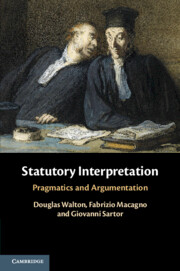Book contents
- Statutory Interpretation
- Statutory Interpretation
- Copyright page
- Dedication
- Contents
- Figures
- Tables
- Acknowledgments
- Introduction
- 1 Interpretation and Statutory Interpretation
- 2 Statutory Interpretation as Problem Solving
- 3 Interpretation and Pragmatics – Legal Ambiguity
- 4 Pragmatic Maxims and Presumptions in Legal Interpretation
- 5 Arguments of Statutory Interpretation and Argumentation Schemes
- 6 Classification and Formalization of Interpretative Schemes
- References
3 - Interpretation and Pragmatics – Legal Ambiguity
Published online by Cambridge University Press: 29 December 2020
- Statutory Interpretation
- Statutory Interpretation
- Copyright page
- Dedication
- Contents
- Figures
- Tables
- Acknowledgments
- Introduction
- 1 Interpretation and Statutory Interpretation
- 2 Statutory Interpretation as Problem Solving
- 3 Interpretation and Pragmatics – Legal Ambiguity
- 4 Pragmatic Maxims and Presumptions in Legal Interpretation
- 5 Arguments of Statutory Interpretation and Argumentation Schemes
- 6 Classification and Formalization of Interpretative Schemes
- References
Summary
This definition is only apparently clear and simple. In fact, in order to understand what it means exactly, it is necessary to analyze first the concept of [§1.1] interpretation and then the related concepts of [§1.2] ambiguity, [§1.3] ordinary meaning, and [§1.4] vagueness.
- Type
- Chapter
- Information
- Statutory InterpretationPragmatics and Argumentation, pp. 97 - 156Publisher: Cambridge University PressPrint publication year: 2021
References
References
Cases cited
Church of the Holy Trinity v. United States 1892 143 U.S. 457.
Department of Housing & Urban Development v. Rucker 2002 535 U.S. 125.
District of Columbia v. Heller 2008 554 U.S. 570.
Moskal v. United States 1990 No. 498 U.S. 103.
Muscarello v. United States 1998 no. 524 U.S. 125.
Smith v. United States 1993 508 U.S. 223.
United States v. Missouri Pacific R.R. Co. 1929. 278 U.S. 269.



